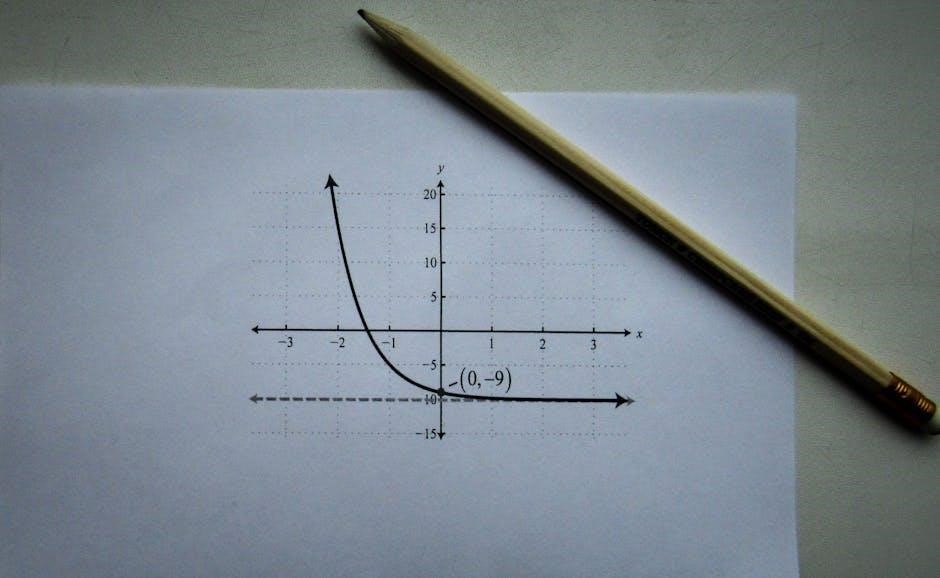The empirical formula represents the simplest whole-number ratio of atoms in a compound, while the molecular formula shows the actual number of atoms. Understanding these concepts is crucial for identifying chemical compounds and their properties, as they form the foundation of chemical nomenclature and structural analysis.
1.1 Definition of Empirical Formula
The empirical formula is the simplest whole-number ratio of the different elements present in a compound. It is derived by converting the mass percentages of each element into moles and then simplifying the ratio to the smallest whole numbers. For example, if a compound contains 40% carbon, 6.7% hydrogen, and 53.3% oxygen by mass, the empirical formula is determined by dividing each element’s mass by its atomic mass to find the mole ratio, which is then reduced to the simplest form. This formula provides a concise representation of the relative quantities of atoms in the compound, making it a fundamental tool in chemical analysis and nomenclature.
1.2 Definition of Molecular Formula
The molecular formula specifies the actual number of atoms of each element in a single molecule of a compound. It is derived by scaling the empirical formula to match the compound’s molar mass. For instance, if the empirical formula is CH₂O and the molar mass is 180 g/mol, dividing the molar mass by the empirical formula’s mass gives the scaling factor (6), resulting in the molecular formula C₆H₁₂O₆. This formula provides detailed structural information essential for understanding chemical properties and reactions, distinguishing it from the empirical formula, which only shows the simplest ratio of atoms.
1.3 Importance of Understanding Formulas in Chemistry
Understanding molecular and empirical formulas is essential in chemistry as they provide critical insights into a compound’s composition and properties. These formulas are fundamental for chemical nomenclature, synthesis, and analysis. They enable chemists to determine stoichiometric relationships, predict chemical behaviors, and identify substances. In fields like pharmacy, environmental science, and materials engineering, knowing these formulas is vital for developing new compounds and understanding their interactions. Mastery of these concepts is also crucial for solving practical problems and interpreting experimental data, making them a cornerstone of chemical education and research.

Steps to Determine Empirical and Molecular Formulas
Calculate mass percentages, convert masses to moles, find the simplest whole-number ratio for the empirical formula, and use molar mass to determine the molecular formula.
2.1 Calculating Mass Percentages of Elements
Calculating mass percentages involves determining the proportion of each element in a compound relative to its total mass; This is done by dividing the mass of each element by the compound’s total mass and multiplying by 100. For example, if a compound contains 0.783g of Carbon, 0.196g of Hydrogen, and 0.521g of Oxygen, the total mass is 1.5g. The mass percentage of Carbon is (0.783/1.5)×100 = 52.2%, Hydrogen is (0.196/1.5)×100 = 13.1%, and Oxygen is (0.521/1.5)×100 = 34.7%. Accurate mass percentages are essential for determining the empirical formula.
2.2 Converting Mass to Moles
Converting mass to moles is a critical step in determining chemical formulas. To do this, the mass of each element is divided by its molar mass, which is found on the periodic table. For example, if a compound contains 0.783g of Carbon (molar mass = 12.01 g/mol), the moles of Carbon are 0.783 / 12.01 ≈ 0.0652 mol. Similarly, for Hydrogen (0.196g, molar mass = 1.008 g/mol), the moles are 0.196 / 1.008 ≈ 0.1945 mol. This process is repeated for all elements present, ensuring accurate calculations for the next steps in finding the empirical formula.
2.3 Finding the Simplest Whole-Number Ratio
After converting masses to moles, the next step is to determine the simplest whole-number ratio of the elements. Divide each mole value by the smallest number of moles present. For instance, if a compound has 0.0652 mol of Carbon, 0.1945 mol of Hydrogen, and 0.0325 mol of Oxygen, dividing each by 0.0325 gives approximately 2 for Carbon, 6 for Hydrogen, and 1 for Oxygen. This results in the empirical formula C₂H₆O. If the ratio isn’t whole numbers, multiply through by a common factor until whole numbers are achieved, ensuring the simplest form is obtained.
2.4 Determining the Molecular Formula Using Molar Mass
To determine the molecular formula, first calculate the molar mass of the empirical formula. Then, divide the compound’s molar mass by the empirical formula’s molar mass to find the multiplier. Multiply the empirical formula by this whole number to obtain the molecular formula. For example, if the empirical formula has a molar mass of 30 g/mol and the compound’s molar mass is 90 g/mol, the multiplier is 3. Thus, the molecular formula is three times the empirical formula. If the molar masses are equal, the molecular formula is identical to the empirical formula.

Common Elements in Empirical and Molecular Formulas
Common elements include Carbon (C), Hydrogen (H), Oxygen (O), Nitrogen (N), and Sulfur (S). Transition metals like Iron (Fe), Copper (Cu), and Chromium (Cr) also appear frequently. These elements often combine in specific ratios to form compounds, making them essential in both empirical and molecular formulas. Understanding their typical combinations aids in deducing formulas for unknown compounds. For example, Carbon, Hydrogen, and Oxygen are prevalent in organic molecules, while Transition Metals are common in inorganic compounds. This knowledge simplifies the process of determining chemical structures and identifying compounds in various fields of chemistry.
3.1 Carbon, Hydrogen, and Oxygen
Carbon (C), Hydrogen (H), and Oxygen (O) are among the most common elements in empirical and molecular formulas, particularly in organic chemistry. These elements form the basis of biomolecules like carbohydrates, fats, and proteins. For example, glucose has the molecular formula C6H12O6, while water is simply H2O. Their abundance in nature and versatility in bonding make them fundamental in both simple and complex compounds. Understanding their ratios is crucial for determining the identity and properties of substances, as seen in numerous worksheet problems involving these elements. Their combinations often define the molecular structure and functionality of organic and inorganic compounds alike.
3.2 Nitrogen and Sulfur
Nitrogen (N) and Sulfur (S) are key elements in many compounds, often appearing in both organic and inorganic molecules. Nitrogen is a critical component of amino acids, DNA, and proteins, while sulfur is essential in compounds like sulfuric acid (H2SO4) and amino acids such as cysteine. Their atomic properties allow them to form various molecular structures, making their empirical and molecular formulas diverse. For instance, ammonium nitrate has the molecular formula NH4NO3, while sulfur dioxide is SO2. These elements’ unique bonding capabilities make understanding their formulas vital for chemical analysis and synthesis, as seen in many practice problems and real-world applications.
3.3 Transition Metals and Their Compounds
Transition metals, such as iron (Fe), copper (Cu), and chromium (Cr), form compounds with distinct empirical and molecular formulas. These metals often exhibit multiple oxidation states, leading to diverse compounds like Fe2O3 (iron(III) oxide) and CuO (copper(II) oxide). Their formulas are determined by balancing charges and ensuring whole-number ratios of atoms. For example, chromium oxide (CrO3) and titanium dioxide (TiO2) showcase how transition metals bond with nonmetals. Understanding these formulas is essential for material science and chemistry, as seen in practice problems involving metals and their oxides, which are common in educational resources and worksheets.

Practice Problems and Solutions
Solve problems to find empirical and molecular formulas using given masses or percentages. Example: A compound has 0.783g C, 0.196g H, and 0.521g O. Calculate moles, find ratios, and determine formulas.
4.1 Example 1: Compound with 0.783g C, 0.196g H, and 0.521g O
Calculate moles: C = 0.783g / 12.01 = 0.0652 mol, H = 0.196g / 1.008 = 0.1945 mol, O = 0;521g / 16.00 = 0.03256 mol. Divide by the smallest mole value (O): C = 2, H = 6, O = 1. The empirical formula is C₂H₆O.
4.2 Example 2: Compound with 89.14% Au and 10.80% O
Convert percentages to grams: Assume 100g sample → Au = 89.14g, O = 10.80g. Calculate moles: Au = 89.14 / 197.0 ≈ 0.4525 mol, O = 10.80 / 16.00 ≈ 0.675 mol. Divide by the smallest mole value (Au): Au ≈ 1, O ≈ 1.49 ≈ 1.5. To get whole numbers, multiply by 2: Au = 2, O = 3. The empirical formula is Au₂O₃.
4.3 Example 3: Compound with 43.7% P and 56.3% O
Convert percentages to grams: Assume 100g sample → P = 43.7g, O = 56.3g. Calculate moles: P = 43.7 / 30.97 ≈ 1.41 mol, O = 56.3 / 16.00 ≈ 3.52 mol. Divide by the smallest mole value (P): P ≈ 1, O ≈ 2.5. To get whole numbers, multiply by 2: P = 2, O = 5. The empirical formula is P₂O₅.
Given the molar mass of 284 g/mol, calculate the molecular formula. The empirical formula mass is (230.97) + (516.00) = 141.94 g/mol. Divide the molecular mass by the empirical mass: 284 / 141.94 ≈ 2. Thus, the molecular formula is P₄O₁₀.

Answer Key and Explanations
Provides detailed solutions for determining empirical and molecular formulas, including step-by-step calculations, ratio determinations, and molar mass applications to verify correctness and understanding of chemical principles.
5.1 Empirical Formula Answers
This section provides clear solutions for determining empirical formulas, including step-by-step calculations and examples. For instance, a compound with 0.783g C, 0.196g H, and 0.521g O yields the empirical formula CH₂O. Each solution outlines the process of converting masses to moles, finding the simplest whole-number ratio, and deriving the formula. Key examples highlight common scenarios, such as when the molecular formula matches the empirical formula due to molar mass equivalence. This ensures clarity and reinforces understanding of chemical composition principles.
5.2 Molecular Formula Answers
Determining molecular formulas involves using the empirical formula and molar mass. For example, a compound with 43.7% P and 56.3% O has an empirical formula of PO₃. Given a molar mass of 284 g/mol, the molecular formula is calculated as (PO₃)ₙ = 284 g/mol. Solving for n gives n=4, resulting in P₄O₁₂. Similarly, a compound with 89.14% Au and 10.80% O has an empirical formula of AuO. With a molar mass of 232 g/mol, the molecular formula is Au₂O₃. These examples demonstrate how molar mass expands the empirical formula to reveal the molecular structure.
5.3 Common Mistakes and Corrections
Common errors include incorrect conversion of percentages to grams or molar ratios. For instance, miscalculating moles by dividing by the wrong atomic mass leads to incorrect ratios. Another mistake is assuming the empirical and molecular formulas are the same without verifying with the molar mass. Additionally, forgetting to reduce the ratio to the simplest whole numbers can result in an inaccurate empirical formula. Careful attention to unit conversions and accurate mole calculations are essential to avoid these pitfalls and ensure correct molecular and empirical formulas. Regular practice helps refine these skills and minimize errors.
Real-World Applications of Formulas
Understanding molecular and empirical formulas is vital in pharmacy, environmental science, and materials engineering for creating drugs, analyzing pollutants, and designing advanced materials efficiently.
6.1 Chemical Nomenclature and Labelling
Chemical nomenclature relies heavily on molecular and empirical formulas for accurate naming and labeling. These formulas are essential for identifying substances in laboratories, ensuring safety, and compliance with regulations. By understanding these formulas, chemists can systematically name compounds, which is crucial for clear communication and documentation. This standardization is vital in industries like pharmaceuticals and manufacturing, where precise labeling ensures the correct handling and use of chemicals. The ability to derive formulas from compositions is a cornerstone skill in chemistry education and professional practice;
6.2 Pharmaceutical and Organic Chemistry
In pharmaceutical and organic chemistry, molecular and empirical formulas are fundamental for drug development and synthesis. These formulas help determine the composition of active pharmaceutical ingredients, ensuring their efficacy and safety. By calculating formulas from experimental data, chemists can design and optimize drug molecules, leading to breakthroughs in medicine. This process is critical in creating life-saving treatments and underscores the importance of precise chemical analysis in the pharmaceutical industry.
6.3 Environmental and Material Science
Molecular and empirical formulas are essential in environmental science for analyzing pollutants and understanding chemical reactions in ecosystems. In material science, these formulas aid in developing new materials by determining their composition and structure. For example, identifying the molecular formula of air pollutants helps assess their environmental impact. Similarly, in creating advanced materials like semiconductors or ceramics, knowing the empirical formula ensures precision in their design and functionality. This knowledge drives innovation and problem-solving in both fields, contributing to sustainability and technological advancement.

Additional Resources and Worksheets
Access PDF worksheets with practice problems and answers to master empirical and molecular formulas. Utilize online tools for calculations and video tutorials for interactive learning.
7.1 Recommended PDF Worksheets for Practice
Download PDF worksheets like “Empirical and Molecular Formula Problems ౼ Set I” and “Empirical Formula Practice Worksheet” for hands-on practice. These resources include problems with answers, covering compounds of various elements like carbon, hydrogen, oxygen, nitrogen, and sulfur. They also address transition metals and common molecular compounds. Interactive lessons and detailed solutions help reinforce concepts, making them ideal for self-study or classroom use. Popular PDFs such as “Determining Molecular Formulas (True Formulas)” and “Empirical Formula Problems ౼ Set II” are highly recommended for comprehensive practice.
7.2 Online Tools for Calculating Formulas
Utilize online tools like molecular formula calculators and empirical formula calculators to simplify your practice. Websites such as Formula Calculators and Molar Mass Calculators offer step-by-step solutions for determining formulas. Tools like Chemical Formula Calculator and Empirical Formula Finder are designed to handle mass percentages and molar masses efficiently. Additionally, Stoichiometry Calculators can assist with complex ratio problems. These resources are invaluable for verifying answers and exploring different problems. They provide interactive learning experiences, making them ideal for both students and professionals seeking to refine their skills in molecular and empirical formula calculations.
7.3 Video Tutorials and Interactive Lessons
Enhance your understanding with video tutorials and interactive lessons available on platforms like YouTube, Khan Academy, and Coursera. These resources provide step-by-step explanations of empirical and molecular formula calculations. Interactive simulations, such as those found on PhET Interactive Simulations, allow you to explore chemical concepts visually. Additionally, platforms like Mastering Chemistry offer adaptive practice exercises and quizzes. These tools are ideal for visual learners and those who benefit from hands-on engagement, making complex concepts more accessible and easier to grasp.
